Jokulsarlon glacier lagoon—the silent kingdom of ice, the jewel of Europe’s largest glacier, one of the most iconic attractions in Iceland. It’s a place where time stands still, broken only by the cheerful squeaks of birds and playful peeks of seals from the water. You’ll be blown away by the sheer vastness and shimmering beauty of drifting icebergs—some as tall as multi-story buildings. Visit Iceland's most stunning glacier lagoon, which holds the secrets of a thousand-year-old ice, and lose yourself in its blue and white beauty.

The iceberg lagoon, bathed in soft sunset light, looks peaceful and romantic. Photo by Gunnar Gaukur.
Jökulsárlón lagoon is the deepest glacial lake in Iceland, formed just about 100 years ago, located in the southern part of Vatnajökull National Park. With its ice-age-like landscape, grand atmosphere, and rich local wildlife, the site pulls in plenty of travelers worldwide.
The lagoon’s most distinct feature is the massive icebergs that float quietly in pure glacial waters. Calved from the Breiðamerkurjökull outlet, they drift slowly through the lake, creating a cinematic, otherworldly appearance that has stolen the hearts of many movie directors.
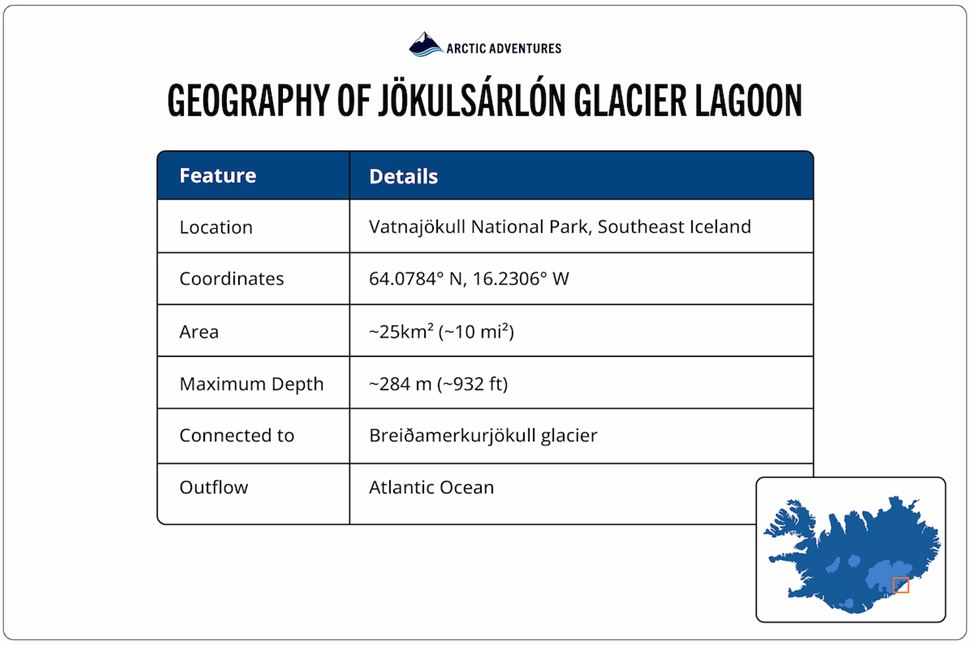
Geographical features of Jökulsárlón Glacier Lagoon. Info Source: eros.usgs.gov; mbl.is
Icelandic glaciers cover nearly 10% of the country’s surface. These immense ice fields, which appear still and frozen, move and change under their own pressure and in response to shifts in weather. As glaciers recede, they form crystalline, meltwater-filled lakes.
Jökulsárlón in Southeast Iceland is a result of glacial movement combined with a rapid climate change during the 20th century’s warming period. Over the years, the lagoon has undergone numerous transformations and continues to grow and reshape.
This Icelandic glacier lagoon connects to Breiðamerkurjökull glacier on one side and flows into the Atlantic Ocean on the other. According to the latest reports, it reaches a depth of 284 m (932 ft) and spans around 25 km² (10 mi²).
The icebergs that float in the water are considered to be more than 1,000 years old. Some are the size of a car, while others rise higher than a six-story building. As the glacier calves and the icebergs shift, the lagoon is constantly changing—no two visits ever look the same.
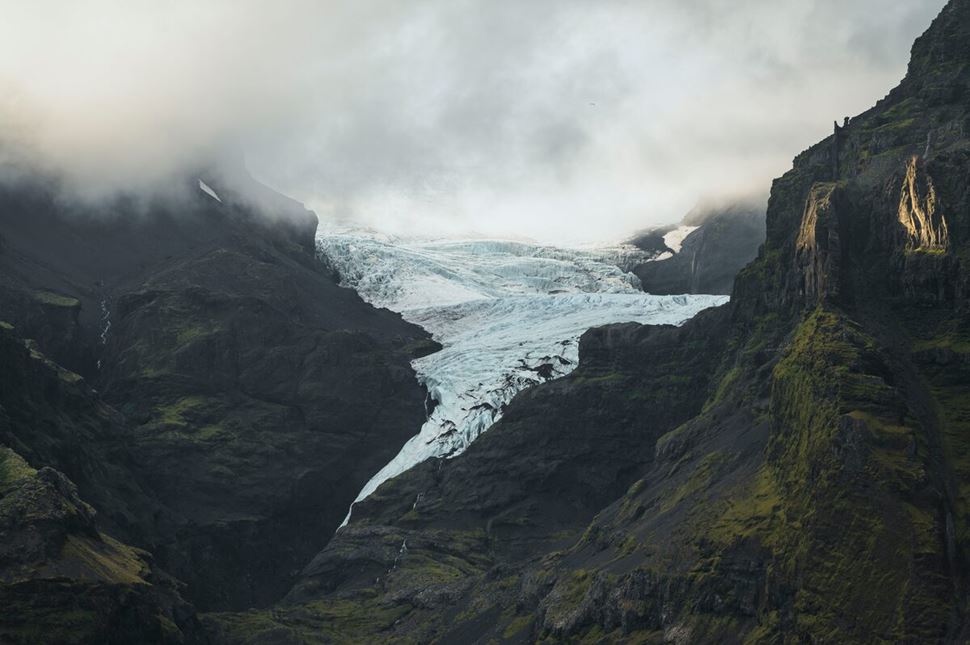
Vatnajökull glacier stretches down the mountain like a frozen river. Photo: Gunnar Gaukur.
Jökulsárlón glacier lake started forming around 1930, when Breiðamerkurjökull—an outlet of Europe’s largest ice cap, Vatnajökull—began to recede. As the glacier pulled back, it carved a large hollow in the land, which gradually filled with meltwater. Since then, the lagoon has expanded rapidly. Over the last 50 years, it’s quadrupled in size and now holds the record as Iceland’s deepest lake.
Although much smaller today, Breiðamerkurjökull ice cap has not eroded entirely. It continues to feed the lagoon with icebergs that break away from the main mass and float in the water before making their way into the ocean.
Hands down, Iceland is one giant green screen come to life—colorful rhyolite mountains, ancient, moss-covered cliffs, and towering waterfalls with rainbows arching over them. It’s no surprise that the country of such haunting beauty has been a backdrop for so many great movies.
Jökulsárlón lagoon, however, with its serene waters and surreal-looking icebergs, has captured the special attention of Hollywood. Several blockbuster films have been shot there, including 2001’s Lara Croft: Tomb Raider, and two James Bond classics: 1985’s A View to a Kill and 2002’s Die Another Day. The lagoon has also appeared in Justin Bieber’s music video “I’ll Show You.”
Curious what else makes Jökulsárlón in Iceland stand out? Besides becoming the country’s deepest lake in less than 100 years, this glacier lagoon connects with the ocean through Iceland’s shortest river, Jökulsá. Its stream is less than one kilometer (0.6 mi) in length.
Another adorable fact—seals absolutely love it here. They lounge lazily on the icebergs, enjoying the crisp air and the sun. You can observe them from a distance at the viewpoint over Jökulsárlón or up close on a guided boat tour.
Jökulsárlón is located right on Iceland’s main highway between the towns of Vik and Höfn, at the edge of the retreating Breiðamerkurjökull glacier.
Thanks to its convenient location on Route 1 (Ring Road) (see Jökulsárlón map above), getting to the lagoon is easy. The highway is regularly maintained and accessible even in winter.
The journey from Reykjavik to Jökulsárlón takes approximately 5 hours by car. The drive from the coastal village of Vik to Jokulsarlon is much shorter—about 2.5 hours. If you’re traveling from the opposite direction, like the town of Höfn, it’s only an hour.
You can reach the lake in multiple ways: rent a car and drive yourself, use public transportation, or join a guided tour with a pre-planned route and itinerary. Choose what suits your travel style.
Jokulsarlon is one of the beloved self-driving destinations in Iceland. To reach Jökulsárlón glacier lagoon from Reykjavik by car, follow Route 1 in a counterclockwise direction for 380 km (236 mi). Leaving the capital at 6:00 AM allows you to visit the lake and other coastal gems, such as Reynisfjara beach, on the same day. Of course, this depends on traffic, weather conditions, and season.
If you’re traveling from the eastern side, such as the town of Höfn, the distance is about 80 km (50 mi). Enjoy a scenic drive along the Ring Road with a glacier on one side and the ocean on the other.
Car rentals are widely available across Iceland. You can rent a vehicle in major cities like Reykjavík, Höfn, or Akureyri, or directly at Keflavík International Airport upon arrival, making it easy to drive to the site. Jökulsárlón parking is conveniently located near the lake and costs about 1,000 ISK (~$6) per car.
If you don’t have a license and wonder how to get to the glacier lagoon, you can take a public bus from Reykjavik to Jokulsarlon. Bus 51 departs from Mjódd shopping center. It takes approximately 7 hours and costs around 15,000–22,000 ISK (~$130–180) per person.
Another option is to join a guided tour. Many tours, from day trips to multi-day adventures, include Jökulsárlón as a stop, along with a variety of other destinations and activities. Private, exclusive tours are also available for a fully customized visit to the lagoon.
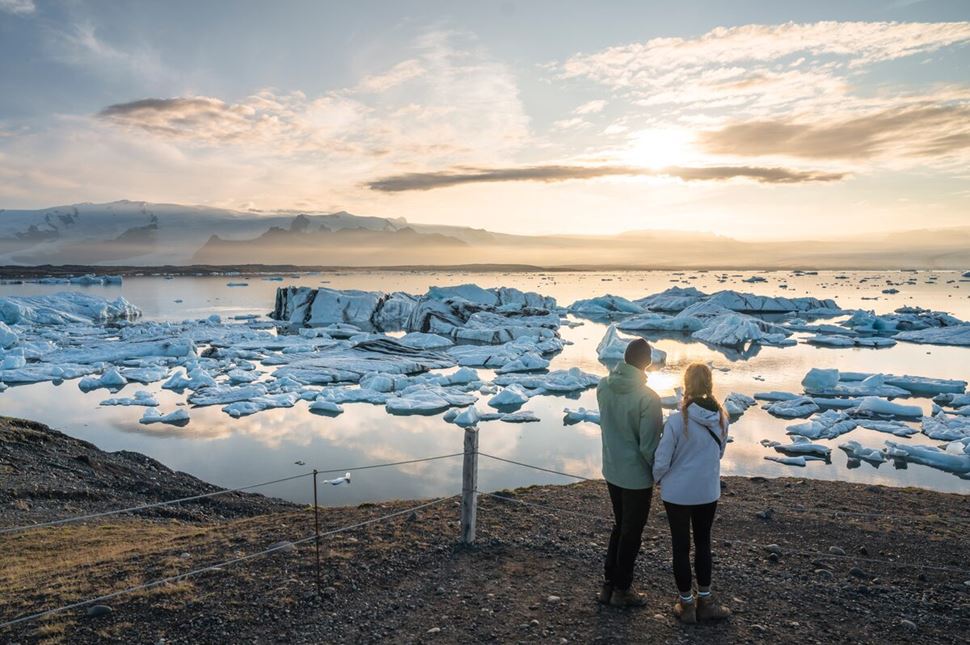
You can admire the glacier lagoon from the shore or take a boat tour. Source: Arctic Adventures.
Jokulsárlón attracts visitors not only for its breathtaking beauty but also for wildlife viewing, photography, and unforgettable sightseeing adventures. One of the most exciting ways to discover this frozen bay is from the water. Jökulsárlón boat tours let you glide among towering icebergs, nearly touching these shimmering icy giants. After such a thrilling experience, you can warm up and relax at the cozy on-site café. Explore various Jokulsarlon Glacier Lagoon tours and start planning your trip to the blue sanctuary of Vatnajökull.
Jökulsárlón tours tick all the boxes for versatility, fitting different travel preferences. Multi-day South Coast itineraries pair the lagoon with glacier hikes, waterfall visits, and more. There are also family-friendly guided day tours from Reykjavík or Höfn that offer a more intimate boat experience. Discover Amphibian tours, Zodiac raft tours, kayak tours, and choose your preferred perspective to uncover the magic of Iceland’s deepest lake and its surroundings.
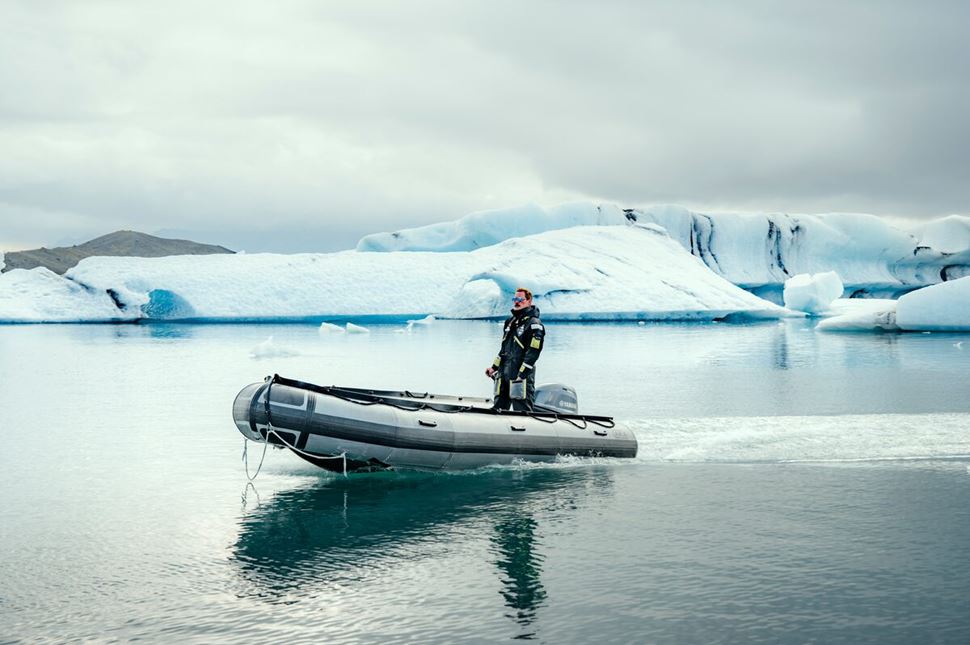
Fast and sturdy, Zodiac boats are made for drifting among the icebergs. Image by Gunnar Gaukur.
Among all the ways to explore Iceland by boat, few compare to floating on a glacier lagoon. Glide right next to majestic icebergs on a Jökulsárlón Zodiac tour, or enjoy a smooth Amphibian boat tour, suitable for visitors of all ages.
Jökulsárlón glacier lagoon boat rides last for about one hour and are available during the summer months (May to October). Whichever vessel you pick, prepare to be transported into a surreal realm of towering ice sculptures, with seals swimming around—a memory that’s impossible to erase.
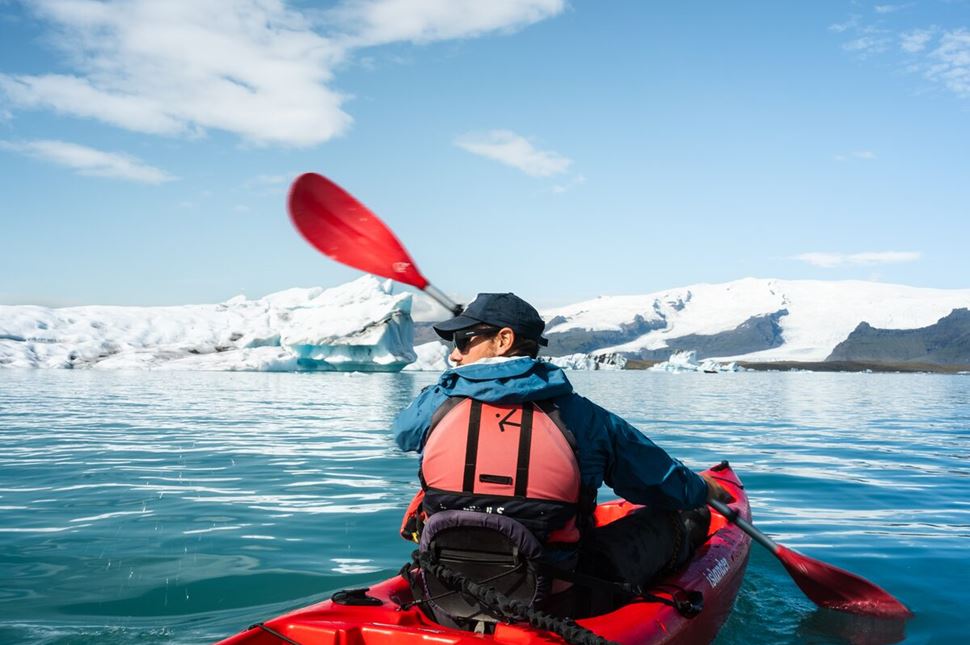
Kayaking between ice blocks at Jökulsárlón brings excitement to the next level.
If you enjoy sports and unique experiences, try Jökulsárlón kayaking—where else can you paddle among the icebergs with a glacier looming in the background? Glide across the lake’s mirror-like surface and feel the splashes of its ice-cold water on your skin.
Available from May to September, Jökulsárlón kayak tours require some level of fitness, but are generally suitable for first-time paddlers aged 14 and older. For approximately 90 minutes, you’ll take in the otherworldly vistas and witness seals playing between the ice blocks. The kind of quiet thrill you’ll want to relive again and again.
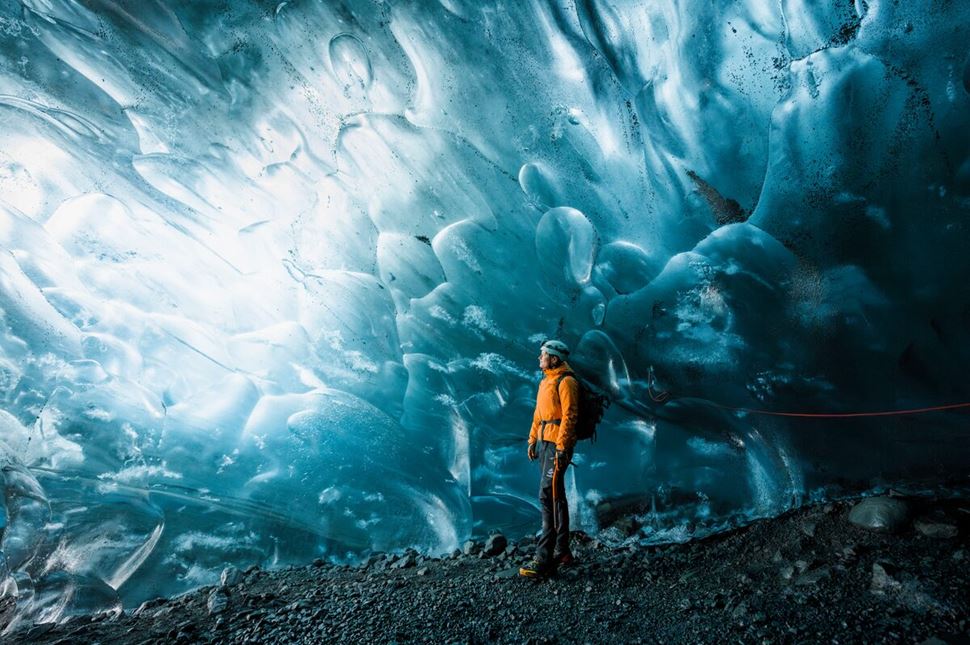
Located near Jökulsárlón, the Crystal Ice Cave can be explored from the inside. Captured during one of our tours.
Your camera won’t believe its lens when sightseeing at Jokulsarlon—those white and blue expanses make for perfect photo opportunities. Capture the beauty early in the morning or evening when the light is softest and curious seals are most active.
A visit to the glacier lagoon can also be part of a bigger Icelandic adventure. Combine Jökulsárlón with a glacier hike in summer, or with a Northern Lights hunt in winter, and capture even more postcard-worthy shots.
Jokulsarlon lagoon is not the only natural masterpiece formed by the Breiðamerkurjökull outlet. The glacier also hides many natural ice caves, accessible from the lagoon. The most famous Jökulsárlón ice cave is the Crystal Cave—a shimmering chamber you can enter from October to April on a guided tour from Jokulsarlon. This experience is captivating to visitors of all ages and backgrounds. Watch the light seeping through the translucent walls and lose yourself in a beautiful moment of silence.

Rope fences at Jökulsárlón help to keep a safe distance from the lake. Photo taken by Gunnar Gaukur.
Seals love Jokulsarlon as much as visitors love to observe these goofy animals lounging on big blocks of ice. It’s as if the icebergs were made to be comfortable beds for these glacier sunbathers. Watching seals is a fun and mood-boosting activity, perfect for the whole family. Give it a go!
Note: When on a Jökulsárlón glacier tour, remember that you enter these animals’ natural habitat. Keep a respectful distance from the seals, refrain from feeding any wildlife, and don’t attempt to climb on the icebergs.
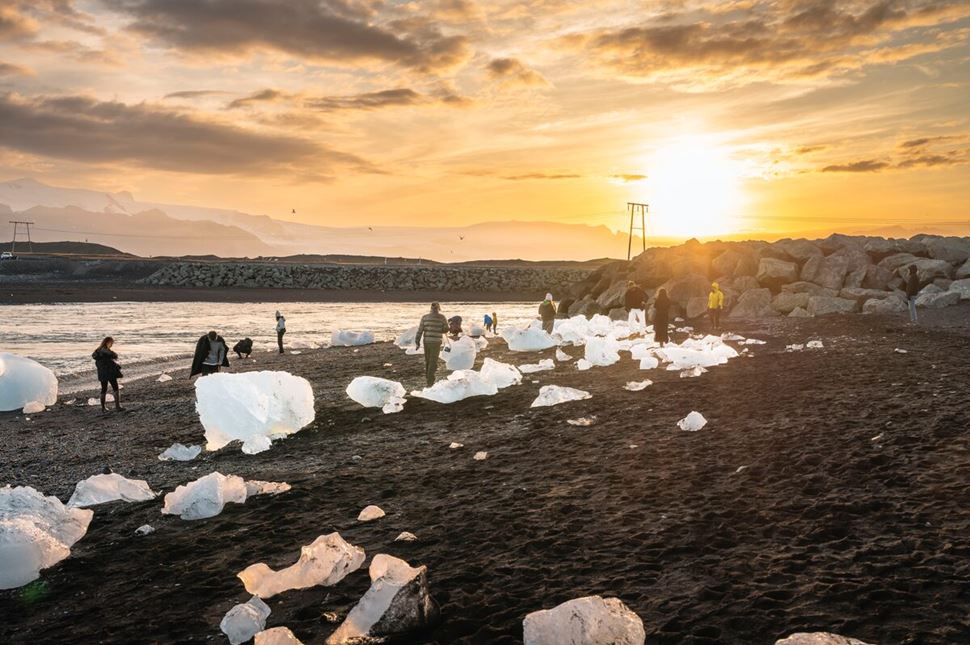
Icebergs washed ashore at Diamond Beach glisten like treasures in the sun. Image: Arctic Adventures.
No trip to Jokulsarlon is truly complete without a visit to the most famous glacier beach in Iceland. This striking black sand gem lies just a short walk from the lagoon.
As pieces of ice drift from the lake to the ocean, some wash ashore on the volcanic area across from the lagoon. The place has been nicknamed the Diamond Beach, Jökulsárlón, as icebergs, resting on the obsidian-colored sands, glisten in the sun like real jewels.
You can stroll along the shore, observing pieces of an ancient glacier up close. Some chunks are as small as rocks, others larger than cars. These shimmering ice sculptures, set against the dark volcanic sand, create a scene unlike any other.
This romantic setting has allowed the Diamond Beach to live up to its name in more ways than one—people from around the world come here to propose to their lovers!
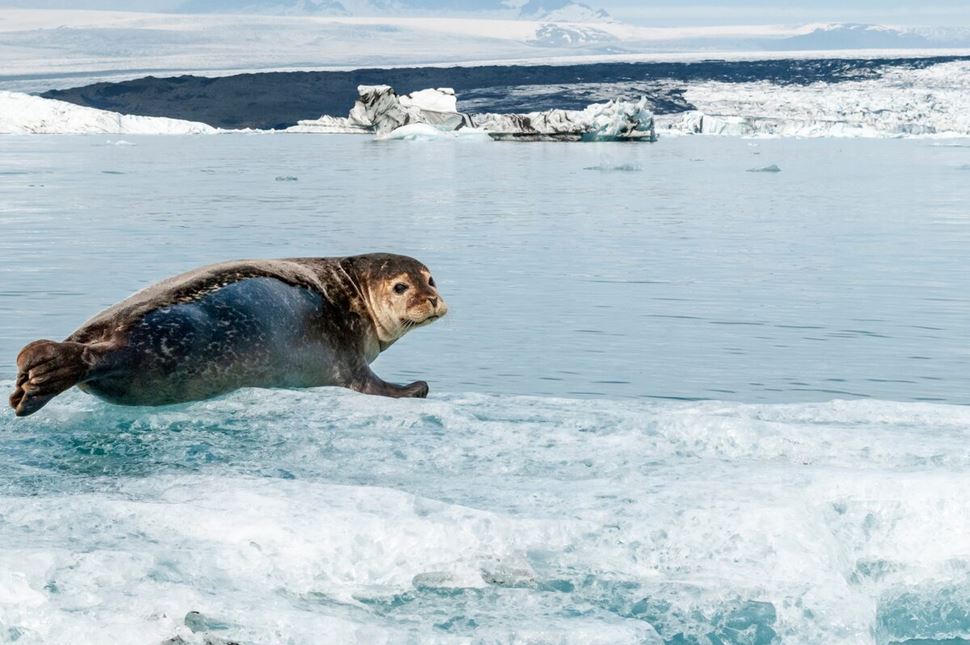
Seals are the full-time residents of Jökulsárlón lagoon.
Jökulsárlón, Iceland, is home to an abundance of wildlife, from fish to mammals and birds. Underwater inhabitants include salmon and trout, as well as small capelin glistening their silver fins.
While spotting fish can be a bit challenging, witnessing seals is guaranteed. Relaxed and unbothered, they stretch out on the ice during the day, then slip into the water later to hunt. Those who are extremely lucky may even glimpse a whale visiting the lagoon to feed.
Birdwatchers will be more than satisfied at Jökulsárlón. Many species of seabirds live there, including sea eagles, cormorants, guillemots, and more. The king of the skies over Jokulsarlon, however, is the Great Skua, boasting a wingspan of more than 120 cm (4 ft). This flying predator is big enough to bully other seabirds and steal their hard-earned dinner.
If you want to maximize your chances of witnessing Icelandic fauna, join an expert-led wildlife tour and observe the animals in their natural habitat up close.

The Northern Lights spectacle unfolding over the glacier lagoon in winter.
Yes, at Jökulsárlón glacier lagoon, Northern Lights dance across the sky every winter. The lack of light pollution and vast open spaces provide a striking background for the lights to glow against. You can capture stunning photos as the colors play with the icebergs and reflect off the dark volcanic sands, creating an incredible display of shadows and textures.
The best time to observe the Jökulsárlón Northern Lights is from September to April, around midnight. Keep a close eye on cloud cover and Aurora forecasts before heading out. To increase your chances of witnessing this magical phenomenon, go with trusted Aurora guides. Consider a three-day tour of the South Coast: spend your days exploring the glacier lagoon and other highlights, and your nights searching for the Northern Lights. If you have more time, a four-day West and South Iceland tour will double your odds of seeing the show.
With so much to see around the lagoon, it's a good idea to stay overnight and make the most of your time in the area. Many travelers base themselves in Höfn, Skaftafell, or Kirkjubæjarklaustur for a few nights. You’ll find hotels, guesthouses, farm stays, hostels, and campsites.
For a quiet hideaway close to the lake, consider Hótel Jökulsárlón—Glacier Lagoon Hotel, only a 12-minute drive away. It has double, triple, and family rooms with glacier views, plus a fitness center, sauna, hot tub, and outdoor area.
In search of budget-friendly accommodation? Try the cozy Reynivellir two-star hotel, 13 minutes from the lagoon. Skyrhúsið Guesthouse is also an excellent option, with its clean, tidy, and homey environment, 14 minutes away.
Prefer to sleep closer to nature? Jökulsárlón has comfortable campgrounds nearby. The Svínafell Campground (40 minutes’ drive away) includes bathrooms, showers, cooking stations, electricity, and is open from May 1st to September 30th. Skaftafell Camping, 45 minutes from the lagoon (open year-round), has the same facilities and a restaurant. Höfn Camping site (1-hour drive away) offers all the essentials, along with a swimming pool, golf course, sports area, and playground.
With no mountain protection and close proximity to the shore, Jokulsarlon is strongly affected by natural forces. Snow and ice make the lagoon harder to reach—if you’re not used to winter driving, it’s best to join a guided tour.
Dress according to recommendations, and you’ll stay comfortable at any time of the year. Learn more about seasonal Jökulsárlón weather patterns and choose the best times to visit.
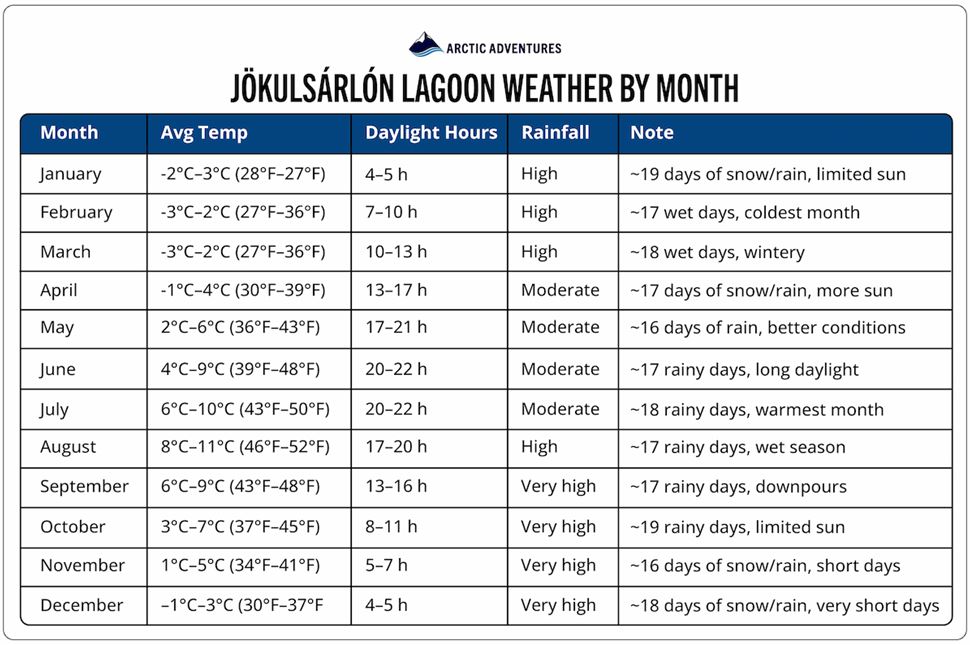
Monthly weather averages (temperature, daylight, precipitation). Info Source: weather-and-climate.com
Temperatures at Jökulsárlón lake range from -1°C to 4°C (30°F–39°F) in winter and 9°C to 14°C (48°F–57°F) in summer. The annual rate of rain or snow varies from about 66 mm (~2.6 inches) in July to around 122 mm (~4.8 inches) in December.
Daylight hours at the lagoon, like the rest of Iceland, fluctuate dramatically—from less than four hours in winter to nearly 24 hours at midsummer (July).
Depending on the season changes, the highlights of Jökulsárlón glacier lagoon in winter include ice caving and Northern Lights hunting. In summer, Jokulsarlon glacier lagoon is perfect for boat tours and photography.
Carefully packing for Iceland’s changing weather is essential for a comfortable and enjoyable trip. Imagine climbing a mountain in summer wearing a heavy wool sweater or standing soaked in the wind—not ideal!
In autumn and spring, bring plenty of easy-to-layer clothes and a waterproof shell, as you might be greeted with wind, sun, rain, and snow all within the same hour.
For summer hikes, sturdy, waterproof boots and merino socks will keep your feet happy. Pack synthetic or wool thermals and avoid cotton, which traps moisture.
In winter, add snow pants, a puffer jacket, a warm hat, gloves, and a scarf to your packing list. Hand warmers are a great bonus for extra coziness.
Jökulsárlón is a magical place, revealing the history of a thousand-year-old glacier right before your eyes. It’s also a striking consequence of global warming. From 1995 to 2019, Iceland’s glaciers lost about 9.6 gigatons of ice per year, and this trend continues to accelerate.
What can you do? Reduce your carbon footprint by recycling all waste, choosing public transportation or electric vehicles, and supporting local, sustainable tour operators.
At Arctic Adventures, we prioritize sustainability and environmental responsibility, striving to set new standards for mindful tourism in Iceland. Our guides constantly educate others on the value of ecological awareness and respect for nature.
Interesting fact: The UN General Assembly has designated 2025 as the International Year of Glaciers’ Preservation and established 21 March as the World Day for Glaciers.
Traveling responsibly means caring for the places you visit. By respecting local flora and fauna, you not only protect nature but also keep yourself safe by reducing the risk of accidents. Knowing what to do (and what not to do) at Jökulsárlón makes your visit both safer and more enjoyable. Check whether you know these tips below!
The most important rules at Jökulsárlón are simple: keep a respectful distance from seals and birds, don’t climb on icebergs, and stay away from the water’s edge. There are also other essential tips to remember:
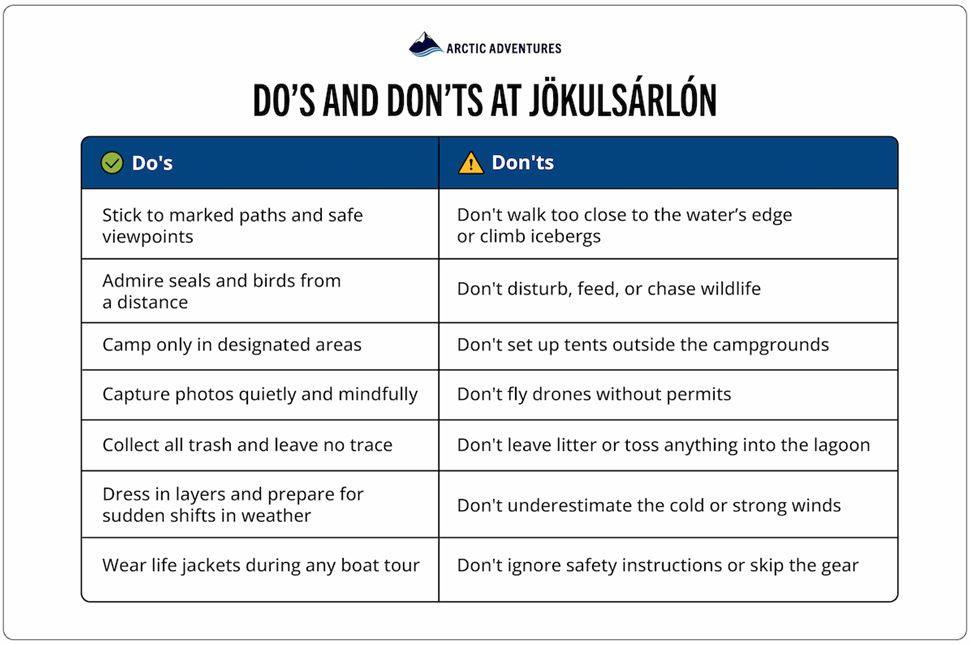
Visitor safety tips and rules for Jökulsárlón Glacier Lagoon. Source: Arctic Adventures.
Don’t fly drones in the entire Vatnajökull National Park to protect the animals and keep the area safe for boat tours. Use the zoom function on your camera to snap that dream Jökulsárlón glacier lagoon photo without disturbing the seals. If you decide to spend the night in nature, pitch a tent only in designated places and don’t leave any trash behind. Wild camping in Iceland is illegal, and you could face a fine for taking that risk. When participating in boat experiences, wear a life jacket, provided on the tour. Finally, wear warm layers to return from the trip happy and healthy.
Jökulsárlón is well equipped for visitors. You’ll find a café near the lagoon offering hot chocolate, sandwiches, and soft drinks. Additionally, Hotel and restaurant Jökulsárlón, located 13 km (8 mi) from the lagoon, serves traditional Icelandic and international dishes. Restrooms are available on-site, and there’s convenient parking 6 minutes’ walk from the lake, which costs about 1,000 ISK (~$7.50). You can pay the parking fee on the Parka App online.
Once you’re in the Jökulsárlón area, it’s worth taking some short detours to the nearby glacier lagoons, hiking spots, canyons, and cultural stops. All within a 15-minute drive or less, these attractions are an excellent addition to your glacier lagoon trip.
Nestled in Vatnajökull National Park, 15 minutes’ drive west of Jökulsárlón, Fjallsárlón is a quieter alternative to this world-renowned attraction. Formed from the outlet glacier, Fjallsjökull, this smaller lagoon is characterized by blue, brown, and black icebergs that float lazily in the water. If you want to see a glacial lake in Iceland while avoiding the crowds, this lovely spot might be it.
Breiðárlón Lagoon is located between Jökulsárlón and Fjallsárlón. It belongs to the Breiðamerkurjökull glacial tongue and is often called an off-the-beaten-path gem because you need a 4x4 to reach it. Breiðárlónis a top choice for nature photographers because of its quiet atmosphere and minimal tourist presence.
This cultural center, located 15.5 km (4.3 mi) from Jökulsárlón lagoon, right by the Ring Road, was built in memory of the famous Icelandic writer Þórbergur Þórðarson. Inside, you’ll find an exhibition about his life and work. The cultural center also has a restaurant serving coffee, home-baked cakes, and hot meals. The menu features Icelandic specialties, including traditional lamb meat soup and trout.
Breiðamerkursandur is a glacial outwash plain, formed by meltwater and sediments from Breiðamerkurjökull glacier, located in the municipality of Hornafjörður. It takes only 12 minutes to reach it on foot from Jokulsarlon glacier lagoon. This spot is famous for being home to the legendary Diamond Beach, which occupies only a small part of its sweeping black sands. Beyond the beach, you can explore endless ash-colored expanses—a mesmerizing world shaped by ice, water, and volcanic forces.
Yes, Jökulsárlón glacier lagoon is worth visiting in every season. It features towering icebergs, chipped from an ancient glacier, and adorable seals swimming in the water. The lagoon is an excellent photo spot and is easily reachable year-round because of its convenient location on Iceland’s main highway, the Ring Road.
The best time to visit Jökulsárlón glacier lagoon is summer (May to September), when you can join boat tours and glide between the icebergs. But the lagoon is worth a visit in any season. If you want to combine your trip with a Northern Lights hunt, winter is the best choice.
No, walking on the icebergs at Jökulsárlón is strictly forbidden and dangerous. These ice blocks are constantly moving and can easily flip over or float away from the shore. Stepping on them would also disturb wildlife. You can observe these icy sculptures safely from the shore or on a guided boat tour.
The entrance to Jökulsárlón glacier lagoon is free of charge. The only fee you need to pay is for parking if you arrive by car. Jökulsárlón parking costs approximately 1,000 ISK (~$7.50).
Jokulsarlon is located about 378 km (235 mi) from Reykjavik. To reach it, follow Road 1 counterclockwise. On the way to the lagoon, you can stop by famous attractions like Skógafoss waterfall, the village of Vik, Svartifoss falls, and others.
Most visitors spend 1 to 3 hours at Jökulsárlón, which is enough to admire the icebergs, watch seals, stroll along Diamond Beach, and take plenty of photos. If you plan to join a boat or kayak tour, allow at least half a day to fully enjoy the experience without rushing.
No, swimming in Jökulsárlón glacial lagoon is strictly prohibited. The water is typically around 0–3°C (32–37°F), and exposure to such temperatures poses serious health risks. On top of that, strong currents and drifting icebergs make swimming extremely dangerous. If you want to experience Jökulsárlón from the water, you can always join a boat or kayak tour.
Blue and black streaks on the icebergs in Jokulsárlón lagoon are caused by various environmental factors. The black streaks come from volcanic ash that gets trapped in the ice over centuries, while the blue color appears when the ice is dense and has few air bubbles. This makes it look bright blue instead of white.
The name Jökulsárlón basically means “glacier-river-lagoon” as it is made up of all three elements. “Jökull” means glacier, “Ár” means river, and “Lón” means lagoon.
The name of the Icelandic lagoon, Jökulsárlón, is pronounced as "Yoe-kuhl-sar-lown". The emphasis is on the first syllable.